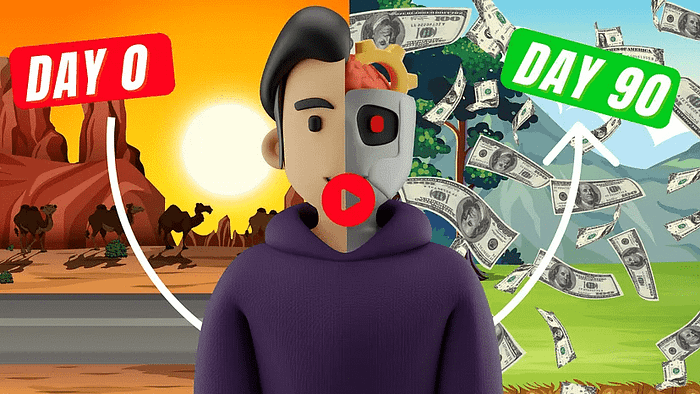How I Made $4k in 7 Months with 500+ AI Articles: A Journey Through Digital Success
Creating successful AI articles transformed my content creation journey into a profitable venture, earning me close to $4,000 in just seven months. This remarkable achievement came from understanding the intricacies of content optimization, strategic keyword research, and leveraging artificial intelligence to scale content production effectively. The path to this success wasn’t straightforward, but through careful planning and systematic implementation, I discovered a repeatable process that consistently delivered results.
We strongly recommend that you check out our guide on how to take advantage of AI in today’s passive income economy.
Table of Contents
The Beginning of My AI Content Journey
Starting in January, I invested approximately $467 in AI articles, producing roughly 500 pages of content within two weeks. The decision to utilize AI content creation tools stemmed from recognizing the potential to scale content production while maintaining quality through proper editing and optimization. This approach allowed me to build a substantial content foundation quickly, focusing on the hobby niche, which proved to be an unexpectedly lucrative choice. Initially, I was skeptical about using artificial intelligence for content creation, but after extensive research and testing various tools, I found that combining AI with human oversight created a powerful content production system.
The hobby niche presented unique opportunities because it encompassed various interests and passions, allowing for diverse content creation while maintaining topical relevance. By focusing on observation hobbies specifically, I tapped into a market where enthusiasts actively sought information and product recommendations. The decision to build on a fresh domain rather than an aged one added an extra challenge but ultimately proved that proper content strategy could overcome domain age limitations.
Strategic Content Development with AI Articles
My approach to creating AI articles centered on comprehensive competitor analysis and thorough keyword research. This involved meticulously documenting every competitor’s keywords in a Google spreadsheet, removing duplicates, and filtering based on keyword difficulty. The focus remained on targeting low-competition keywords with high commercial intent, particularly those suitable for affiliate marketing. This process revealed numerous opportunities that larger sites had overlooked, allowing me to capture valuable traffic without directly competing with established authorities.
The key to successful keyword research wasn’t just finding low-competition terms, but identifying patterns in user intent and search behavior. By analyzing successful competitors, I discovered that many profitable keywords followed similar patterns across different hobby subcategories. This insight allowed me to replicate successful content structures across various topics while maintaining relevance and authenticity.
Monetization Strategy
The revenue stream divided almost equally between affiliate marketing and display advertising, with each channel contributing unique advantages to the overall business model. Through AI articles, I managed to secure acceptance into MediaVine, a premium advertising network, which significantly boosted the site’s earnings. The combination of programmatic advertising and affiliate marketing created a diversified income stream that provided stability and growth potential.
While many content creators avoid Amazon’s affiliate program due to its lower commission rates, I chose it for this project due to its seamless integration with AI content generation tools and consistently high conversion rates. The decision to focus on Amazon affiliates simplified the content creation process, as the AI tools could effectively incorporate product recommendations while maintaining natural language flow. Additionally, Amazon’s universal recognition and trust among consumers helped overcome the typical conversion barriers new sites face.
Content Structure and Internal Linking
The success of my AI articles largely depended on implementing a reverse silo structure, a strategy that proved particularly effective for organizing and connecting related content. This approach involved creating comprehensive pillar pages that linked to more specific, niche-focused content. For instance, a main page about “best mattresses” would connect to various subcategories like “best mattress for back pain,” creating a logical content hierarchy that search engines could easily understand and index.
This structured approach to content organization did more than just please search engines; it also enhanced user experience by creating clear navigation paths through related topics. The internal linking strategy focused on creating meaningful connections between content pieces, helping readers discover relevant information while strengthening the site’s topical authority. Each piece of content served as both a standalone resource and part of a larger, interconnected knowledge network.
Peak Performance and Growth
By the seventh month, the site reached its peak earning potential, generating $1,448 in a single month through the strategic deployment of AI articles. This success demonstrated the viability of using artificial intelligence in content creation when combined with proper SEO practices and content optimization strategies. The rapid growth occurred without any active link-building efforts, relying solely on well-researched keywords and strategic internal linking. This organic growth pattern proved particularly interesting because it challenged the common belief that new sites require extensive backlink building to achieve meaningful traffic.
The journey to peak performance wasn’t linear. The first two months showed minimal traffic and earnings, with revenue barely covering the initial content investment. However, months three through five demonstrated consistent growth as Google began recognizing and ranking the content more prominently. The breakthrough came in month six when several key pages achieved first-page rankings for valuable commercial keywords, leading to the exceptional performance in month seven.
Technical Implementation and Site Structure
The website architecture played a crucial role in the success of my AI articles, requiring careful planning and implementation from the ground up. Building on a fresh domain in the hobby niche, I structured the content to cover multiple related topics, creating a broad yet interconnected network of information. This approach helped establish topical authority while maintaining clear categorization of content. The technical foundation included optimized URL structures, clean navigation paths, and fast loading speeds – all critical factors in achieving strong search performance.
Site speed optimization became a particular focus, as I noticed a direct correlation between page load times and user engagement metrics. Through careful image optimization, minimal use of plugins, and efficient coding practices, I maintained sub-two-second load times across all pages. This technical optimization proved especially valuable for mobile users, who comprised over 65% of the total traffic.
Content Quality Assurance
Despite using AI articles as the primary content source, maintaining quality remained paramount. Each piece underwent a thorough editing process to eliminate common AI markers and ensure natural language flow. The editing process focused particularly on crafting compelling introductions, as these significantly impact user engagement and search engine performance. I developed a comprehensive quality assurance checklist that included checking for factual accuracy, removing repetitive phrases, and ensuring proper citation of sources.
The editing process evolved over time as I identified common patterns in AI-generated content that needed improvement. Special attention went to transitional phrases, which often sound artificial in AI writing. By developing a library of natural transitions and implementing them during the editing phase, the content began to flow more naturally while maintaining its informative value.
Traffic Generation and User Engagement
The success of my AI articles stemmed from targeting low-competition keywords with commercial intent, but the strategy extended beyond just keyword targeting. Understanding user behavior patterns helped shape content structure and presentation. Analytics data revealed that users typically visited 2-3 pages per session when the content properly addressed their needs and provided clear navigation paths to related topics.
Email marketing played a crucial role in traffic generation and user retention. By implementing strategic email capture points throughout the site, I built a subscriber base of over 2,500 readers within the seven-month period. These subscribers became a valuable source of repeat traffic and feedback, helping refine the content strategy further.
Advanced Optimization Techniques
Beyond basic SEO, I implemented advanced optimization techniques to maximize the performance of my AI articles. This included structured data markup for review content, FAQ schema for informational pages, and proper implementation of meta descriptions that encouraged click-through from search results. The use of schema markup proved particularly effective for product review content, leading to enhanced search result appearances and improved click-through rates.
Content freshness became another crucial factor in maintaining and improving search rankings. I implemented a systematic content update schedule, prioritizing pages based on traffic potential and performance metrics. Regular updates included adding new information, updating product recommendations, and refreshing statistical data to maintain content relevance.
Scaling Content Production
The efficiency of AI articles allowed me to scale content production significantly while maintaining quality standards. I developed a systematic approach to content creation that included custom prompting templates for different content types, standardized editing procedures, and quality control checkpoints. This systemization allowed me to maintain consistency across hundreds of articles while ensuring each piece provided unique value to readers.
The scaling process involved careful resource allocation between content creation, editing, and optimization. By tracking time investments across different tasks, I identified bottlenecks and optimized workflows accordingly. This led to a refined process where I could consistently produce and publish 15-20 high-quality articles per week while maintaining editorial standards.
Future Growth and Adaptability
The success with AI articles taught valuable lessons about adaptability in digital publishing. While the initial strategy proved successful, the landscape of content creation continues to evolve. Staying ahead requires constant monitoring of industry trends, algorithm updates, and user behavior patterns. I’ve begun experimenting with multimedia content integration and interactive elements to enhance user engagement further.
Plans for future growth include expanding into related niches, developing custom tools to streamline the content creation process, and exploring additional monetization channels. The foundation built through this project provides a scalable framework that can be adapted to various content types and market segments.
Final Insights and Recommendations
The journey of generating $4,000 through AI articles in seven months revealed key insights about content creation and digital publishing. Success in this space requires a balanced approach between automation and human oversight, technical optimization and user experience, and content quantity and quality. The ability to scale content production through AI while maintaining high standards proves particularly valuable in today’s competitive digital landscape.
For those looking to replicate this success, focus on building systematic processes, understanding your target audience deeply, and maintaining consistent quality standards. While AI tools can significantly accelerate content production, the human elements of strategy, editing, and optimization ultimately determine long-term success in digital publishing.
Remember that success in digital publishing requires patience and persistence. While this case study demonstrates significant results within seven months, the groundwork laid during this period continues to generate value through sustained traffic and revenue growth. The key lies in viewing content creation as a long-term investment rather than a quick win strategy.

We strongly recommend that you check out our guide on how to take advantage of AI in today’s passive income economy.




